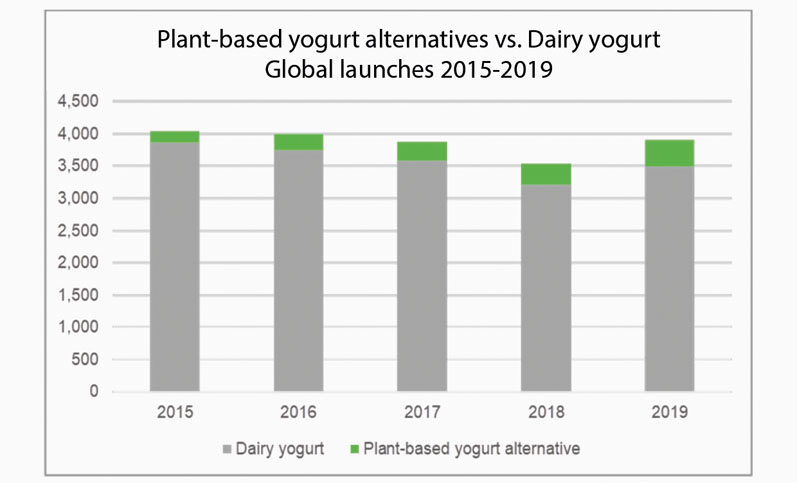Age-old fermentation is seeing a renaissance in these health-conscious times and noticeably so in the category of plant-based dairy alternatives. Innovation in the yoghurt substitute category is especially impressive, with Mintel registering 23% year-on-year growth in global product launches in the 5 years up to 2019 (Figure 1).
Although plant-based fermented beverages have not yet reached the same level of visibility, kombucha is one product that stands out for its rapid rise on store shelves. A report by Mordor Intelligence forecasts the global market for this fermented tea will grow at a rate of 17.5% year-on-year from 2020 to 2025.1
But are fermented plant-based products really the nutritious and sustainable addition to the diet that consumers think they are. Or are their benefits merely a perception established as a result of convincing marketing? After all, compared with dairy, it’s well known that many novel plant bases are lacking in terms of the digestible proteins that are essential to consumers’ nutritional needs.

Figure 1. Source: Mintel GNPD
This is actually where the fermentation process makes a difference. Originally used for food preservation, the process is recognised as a means to unlock plant bases and increase nutrient bioavailability. Beyond that, the opportunities to enrich fermented plant-based beverages and yoghurts are many.
Success is in the culture
In the production of plant-based dairy alternatives, truly successful fermentation requires a specially designed starter culture. The fundamental objective is to break down the carbohydrates in cereals, legumes, vegetables and nuts to enable processing — and support the development of an appealing taste and texture.
However, cultures with proteolytic activity also contribute to the breakdown of proteins, which tend to be less bioavailable in plant sources than in dairy. In some lactic acid bacteria species, extracellular proteolytic enzymes are particularly effective at hydrolysing large protein molecules into peptides and amino acids, which makes them are easier to absorb.
Balancing the enzymes
Getting the balance right in this protein breakdown is critical. For manufacturers, one of the biggest concerns is to ensure that the hydrolysis does not result in the release of bitter-tasting hydrophobic amino acid residues. And this is where it gets technical.Briefly, these enzymes can be divided into endopeptidases — or proteases — and exopeptidases. Although endopeptidases are the most efficient at hydrolysing plant proteins and releasing amino acids for easier digestion, they are often the source of a bitter aftertaste.
Exopeptidases, by contrast, have the ability to break down proteins with less bitterness. When both enzyme types are present in the right proportions, manufacturers can benefit from a synergistic effect that optimises protein bioavailability without compromising taste.
More protein, less sugar
Whereas this enzyme activity gives access to available proteins, it does not compensate for the fact that plant bases such as oat, almond and rice are comparatively low in protein. This accounts for the growing interest in fortification with other proteins, such as soy and pea, which can increase and complete the amino acid content.
In the production of cereal-based fermented beverages, the addition of amylase and glucoamylase enzymes supports the breakdown of starch to provide a pleasant, drinkable viscosity. Glucose released through this altered carbohydrate composition can also give the fermented base a natural sweetness, reducing the need for added sugar and boosting the nutritional profile.
A probiotic boost
Among consumers, fermentation has long given dairy products such as yoghurt a healthy glow. The same is true of plant-based alternatives, their reliance on fermentation bacteria bestowing them with a “probiotic light.” Like their dairy counterparts, they are stable carriers for probiotic cultures that deliver billions of live and active bacteria.
Numerous clinical studies have documented the ability of specific probiotic cultures to support gut health. Bifidobacterium lactis HN019 and Lactobacillus acidophilus NCFM are two of the most well-studied, both for their impact on gastrointestinal functionality and comfort and their long-term viability in food products.
So, are fermented plant-based dairy alternatives as healthy as consumers might think? The answer is yes, they can be. Through careful management of the fermentation process and targeted nutritional enrichment, manufacturers have every possibility to meet consumer expectations and differentiate their products. With the current rate of market growth, that’s a balancing act worth mastering.
Reference
1. www.mordorintelligence.com/industry-reports/kombucha-market.




